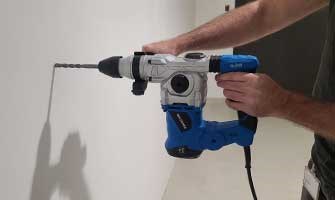How to paint your radiator
Published 2024.12.09
Can you paint a radiator?
You can paint a radiator. In fact, there are several situations where it can be a good idea to give the home's radiators a coat of paint.
- Have your radiators got a few scratches? Then it can be nice to give the radiators a dab of paint.
- Has the color of your radiators become dull over time? Then painting the radiators can give the room a breath of fresh air.
- Resorting to paint can also be a good solution if you have bought an older house where the radiators need some TLC.
Painting the radiators can make a big difference, so it's just a matter of getting started.
Painting a radiator is not always the solution
While it may seem like an easy and quick solution to give your radiator a fresh coat of paint, it is not always the best solution. It is not always that a dab of paint can solve the problem.
If you have a worn radiator with rust or other damage, it may be necessary to consider a repair or maybe even a replacement. Painting the radiator can be a temporary solution, but it does not solve the problem of rust and you risk that the damage will only get worse.
The same applies to radiators that are very worn or have deep scratches. Here it can be difficult to get a nice result with paint, and you should consider whether it is better to invest in a new radiator.
It's important to remember that a radiator is not just a decorative element in your home, but also an important part of your home's heating system. Therefore, you must remember to take into account whether painting your radiators is really the best solution.

What type of paint can be used for radiators?
When painting your radiator, it is important that you choose the right type of radiator paint. You can't just use any paint you have on the shelf. However, it is absolutely essential that you choose paint that is designed specifically for painting radiators. And there are several good reasons for this.
Firstly, radiator paint is developed to be able to handle the high heat that a radiator emits. If you use regular paint, you may risk the paint bubbling, cracking or falling off due to the high and fluctuating temperatures.
Second, radiator paint is designed to adhere well to metal surfaces. This means that the paint will stick better to your radiator, and you will therefore get a more durable and professional result when painting your radiator.
So even though it can be tempting to just use a regular type of paint that you have standing in the basement anyway, it is a good idea to invest in actual radiator paint. This will give you a nicer and more durable result, and you will avoid problems with paint that peels off or does not stick properly. It's a small investment that can make a big difference to the final result.
Radiator paint: Spray paint or liquid paint?
When you start painting your radiators, you can generally choose between two types of paint - either spray paint or liquid paint. Both types of paint have their advantages, and it's basically about assessing what suits your particular type of radiator best.
High quality spray paint is a good solution when you are going to start painting if your radiator has many nooks and corners. The spray paint can get into even the smallest crevices and ensures that the entire radiator is covered with paint. It is a quick and efficient solution that gives a nice and even result.
If, on the other hand, your radiator has several even surfaces, liquid paint may be the ideal choice. With a good brush or paint roller, you can apply the paint precisely and controlled. Liquid paint is also a good choice if you want a thicker layer of paint, as you have the option to build up the layers.
What you need when painting your radiator
When you are about to start painting your radiator, it is important to have all the tools ready in advance. This makes the whole process somewhat easier, and you can concentrate on the painting project itself instead of having to look for tools along the way.
- Primer or primer
With the right tools and materials at hand, you are well equipped to start painting your radiator.
Prepare your radiator for a coat of paint
Preparation is key. And this also applies when you need to paint your radiator. Here, good preparation ensures a beautiful and durable result, and it also helps to make the painting process itself easier. To get ready for the project:
Turn off the radiator: First of all, make sure to let the radiator cool down completely. The paint adheres best to a cold surface, and you also avoid burning yourself while working.
Cover the area: While the radiator cools down, you can use the time to cover the area around the radiator. Paint can be difficult to get off once it has stuck, so it is a good idea to protect both floors and walls with a covering – also behind the radiator. For example, you can use newspapers, plastic to protect the florr or masking cardboard.
Clean the radiator: The radiator should also be cleaned thoroughly before you start painting. Here, it is a good idea to use a primer cleaner and a wrung out cloth that removes grease, dust, dirt and other impurities that can prevent the paint from sticking properly.
Start sanding: Once the radiator is clean, sand it lightly with sandpaper for before re-painting. This creates a rough surface that the paint can adhere to better. It is important to sand the entire radiator and not just the visible parts, otherwise the paint may start to peel off.
Wipe with a cloth: Once the radiator has been sanded, it is important that you wipe it with a cloth. This removes dust and grains of sand from the sanding.
Use a primer or primer: Finally, the radiator should be primed. A primer or primer helps to make the paint adhere better to the surface and gives a nicer and more durable result.
Once you have finished preparing the radiator, your radiator is ready to be painted. The thorough preparation helps to ensure that you get a durable and beautiful result.
How to paint your radiator – step by step
Once you've prepared your radiator, it's time to get to work on the paint itself. We've put together a guide on how to paint your radiator – whether your radiator has a flat front, a slightly wavy surface or large slats.
1. If you have chosen the liquid type of paint, you must first choose the right brush for the job. If you have a radiator with a flat front, a paint roller will be ideal for the large surfaces. If the surface is more wavy, or if it is an old-fashioned radiator with large slats, it may be an advantage to use a smaller brush.
2. Start by applying a thin layer of paint to the radiator. It is important that you paint with thin layers – regardless of whether you use a brush, roller or spray. That way, you avoid the paint running. This gives a nicer and more even result.
3. Once you have painted the entire radiator, the paint should be allowed to dry. Check the packaging of the paint how long it takes for the paint to dry. It is important that you are sure that the paint is completely dry before moving on to the next step.
4. Once the first coat of paint is dry, apply another thin coat of paint. This gives a more durable surface and a more beautiful result.
5. Repeat the process until you are completely satisfied with the final result. It may be necessary to give the radiator several coats of paint before you achieve the desired result - depending on the condition of the radiator and the chosen color.
If you follow the five steps and work carefully, you can easily achieve a professional and long-lasting result.
Maintain your freshly painted radiators
Once you have painted your radiator, it is important that you also keep in mind to maintain it. In this way, the radiator stays beautiful for a longer time. Fortunately, it is easy to take good care of your freshly painted radiator.
First and foremost, it is important to keep the radiator clean. Dust and dirt can easily stick to the radiator and make it dull and dull to look at. You can advantageously wipe the radiator with a dry cloth or vacuum it gently once a week.
Also remember to be careful when moving furniture or doing other activities near the radiator. Even though the paint is durable, it can still get scratches if it is exposed to shocks – for example, from the weekly vacuuming.
It is also a good idea to give the radiator a new coat of paint at regular intervals. The paint can wear out over time, and a new coat of paint can help freshen up the radiator and extend its life. So if you notice that the paint is starting to look tired, it may be time for another coat.



